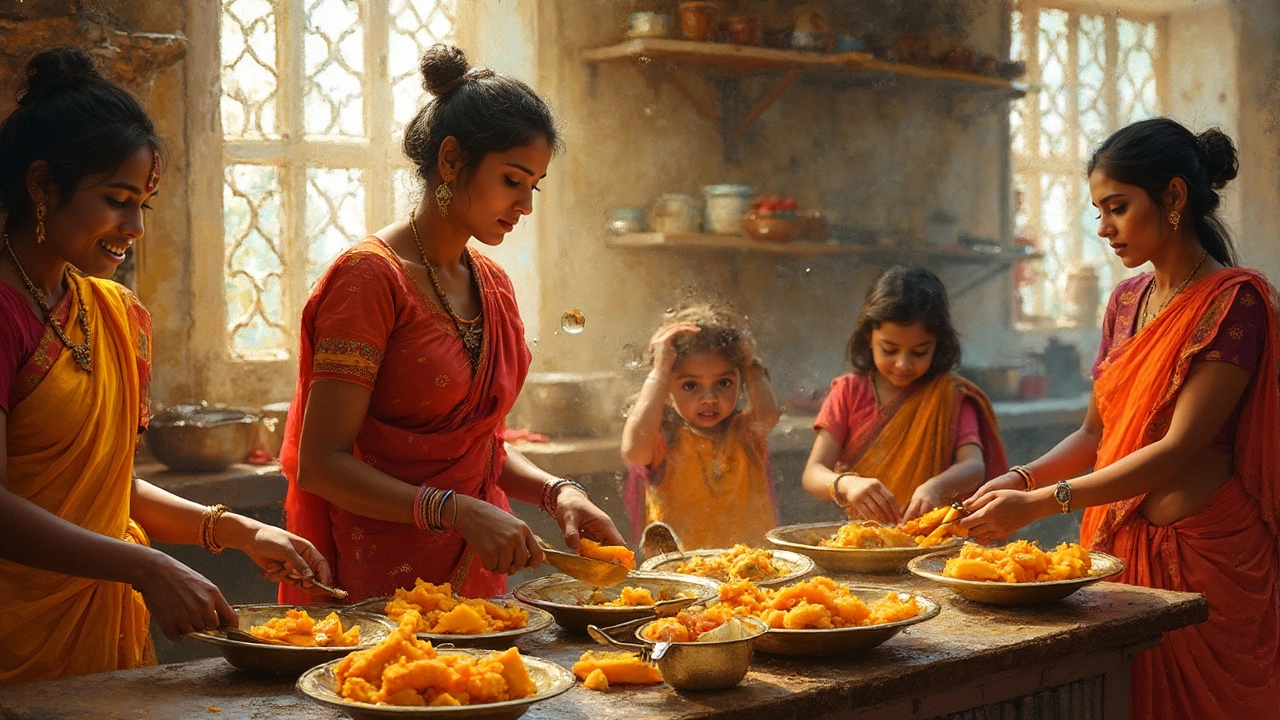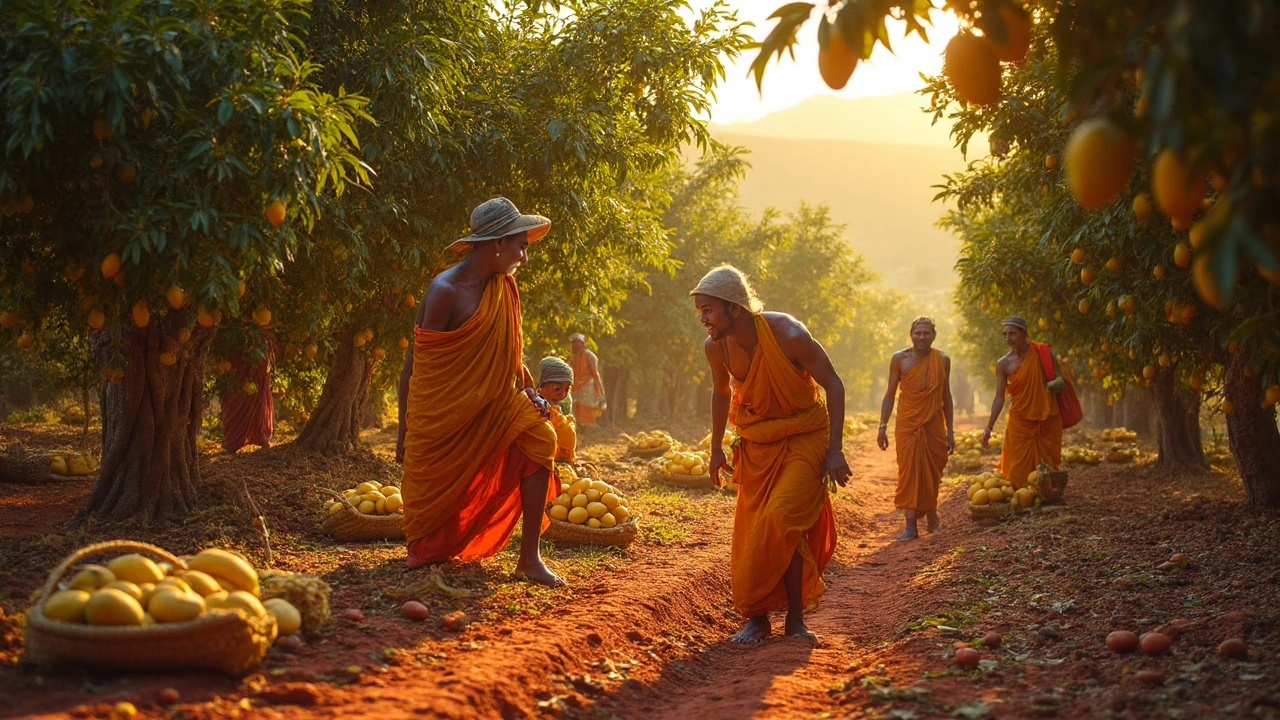Ask anyone in Gujarat what fruit you’ll find everywhere from farm stalls to fancy parties, and the answer comes quick: mango. Not just any mango — the Kesar mango, bright orange, sweet, and dripping with juice. People here are seriously proud of it. They even call it the 'Queen of Mangoes.'
Mango season in Gujarat isn’t just a time on the calendar. It’s really a celebration. Everything from roadside juice shops to home kitchens gets swept up in mango fever. Even if you’ve only tasted a few mango varieties, the Kesar stands out with its rich flavor and super smooth texture. Once you bite into it, it’s hard to go back to any other fruit.
- Why Mango Rules in Gujarat
- Famous Varieties and Where to Find Them
- Mango in Everyday Gujarati Food
- Buying, Storing, and Using Mangoes
Why Mango Rules in Gujarat
Gujarat has its climate to thank for the success of its main fruit — the mango. Hot, dry summers with just enough rain makes for perfect mango weather. The Kesar variety loves the hilly parts around Gir, and that's why Junagadh and neighboring areas have become the go-to spot for these golden beauties. In fact, about 1.2 lakh metric tons of Kesar mangoes are produced in Gujarat every year, mostly in the Saurashtra region.
There’s a cultural pull here, too. Mangoes are everywhere in Gujarati celebrations. You’ll see them being offered at temples, gifted at weddings, and even featured in business deals as a sign of good luck and sweetness in life. Summer in Gujarat really doesn’t feel like summer without fresh mangoes making the rounds in homes and markets.
Here’s why mango rules in Gujarat compared to other fruits:
- The Kesar mango has a protected “Geographical Indication” tag. It means only mangoes from this region can officially carry the Kesar name.
- Mangoes are Gujarat’s top horticulture export. Last year, the state shipped over 16,000 metric tons abroad, mainly to the Middle East.
- Local farmers treat mango farming like a science, focusing on spacing, pruning, harvest techniques, and even using drip irrigation to save water.
- During peak season (May-June), every market in Gujarat is flooded with Kesar and other varieties. It’s common for families to buy 10-20 kilos at once.
Take a look at the numbers:
| Region | Main Mango Variety | Annual Production (MT) |
|---|---|---|
| Saurashtra (Gir, Junagadh) | Kesar | 1,20,000 |
| South Gujarat | Alphonso, Rajapuri | 28,000 |
The love for mango isn’t just taste — it’s tied into history, climate, economy, and everyday life. There’s a reason the main fruit of Gujarat always takes center stage, no matter where you go in the state.
Famous Varieties and Where to Find Them
If you walk through any fruit market in Gujarat during summer, the main fruit of Gujarat popping up everywhere is the Kesar mango. This variety is a superstar around here, especially in the Saurashtra region. The town of Talala in the Junagadh district is famous for producing the best Kesar mangoes. People even travel from other states just to grab boxes straight from these farms.
Kesar’s not alone though. There’s also the Alphonso, locally called "Hapus"—but it mostly grows in neighboring Maharashtra, so it’s not Gujarat’s top pick. Some local fans also talk about Rajapuri mangoes, which are bigger but not as sweet and juicy as Kesar. Payari mango also pops up in southern Gujarat, loved for its aroma but never quite stealing the spotlight from Kesar.
By the numbers, Saurashtra’s mango belt cranks out over 90,000 tons of Kesar every year. That means if you’re looking for mangoes that taste just right—aromatic, smooth, bright orange—hit the Junagadh or Gir region between April and June. You’ll find street vendors, farmers’ markets, and even farm visits where you can sample fruit right under the trees.
Here’s where you’ll spot the most action for each variety:
- Kesar: Talala, Junagadh, Gir, and Amreli
- Rajapuri: Navsari, Valsad
- Payari: Valsad, Surat
Big tip: Always check for the season. Local mango sellers in Gujarat usually open up shop by late April, and things get super busy till early July. You’ll find the freshest picks in small markets right next to the fields—ask any local and they’ll point you in the right direction.

Mango in Everyday Gujarati Food
Once summer hits, mango shows up in almost every Gujarati meal. People don’t just snack on slices—they work this main fruit of Gujarat into all kinds of dishes. In the morning, you’ll find folks stirring mango pulp into their yogurt for a quick breakfast. Sometimes, it’s just fresh Kesar pieces sprinkled with a little salt and chili powder for that sweet-and-spicy kick.
A real classic is aamras—a thick, silky mango pulp served cold, usually with hot puris (fried bread). Restaurants and homes all over Gujarat turn to this combo as soon as mango season starts. Fun fact: on weekends, huge crowds line up at eateries in Surat and Ahmedabad just for fresh aamras-puri plates. No fancy equipment needed: just mangoes, a bit of sugar if you want, and patience to squeeze out every drop.
Mango is big in chutneys and pickles too. People chop up raw green mangoes, toss them with spices, and let them ferment—the result is khatta-meetha (sweet-sour) mango chutney that sits at every thali meal. If you love snacks, don’t miss mango chundo: grated raw mango, pickled with sugar and spices, perfect with thepla or parathas. School kids often sneak a spoonful from jars—moms know this trick but let it slide.
Even for drinks, mango rules. Street vendors and home cooks both whip up fresh mango lassi, a yogurt-based smoothie. You’ll also find the simple, cooling mango panna—a tangy drink made from boiled raw mango pulp, mint, and spices. Especially in May, it beats any store-bought juice for taste and refreshment.
Industrially, Gujarat agriculture pumps out thousands of tons of mangoes each year. Here’s a look at how much mango means to people:
| Dish or Product | Main Ingredient | When You See It |
|---|---|---|
| Aamras | Kesar Mango | Summer, every home/restaurant |
| Mango Chunda | Raw Mango | All year (thanks to pickling) |
| Mango Lassi | Ripe Mango | Summer, road stalls |
| Mango Panna | Raw Mango | May-June, to beat the heat |
If you’re in Gujarat during mango season, ask anyone for their favorite way to eat mango and you’ll get a different answer each time. But one thing stays the same—it’s always the highlight of the meal.
Buying, Storing, and Using Mangoes
If you really want to enjoy the main fruit of Gujarat, grabbing the right Kesar mango makes all the difference. The freshest picks usually show up in local fruit markets around April to June. Look for ones that are slightly soft to the touch and smell sweet near the stem; that’s a good sign they’re ripe. Avoid any that have too many black spots or feel rock hard.
Gujarat’s Talala-Gir area is basically mango central. Fruit from here wins in taste tests every season. Don’t forget—supermarkets will have mangoes, but the open markets or roadside stalls give you that straight-from-the-orchard vibe. Some sellers ship Kesar mangoes direct to homes, packed in sawdust or straw to avoid bruising during travel.
Once home, you’ll want to keep your gujarat mango haul in a cool, dry place. Refrigeration is okay, but only after they’re fully ripe, or you’ll mess with the flavor. Unripe mangoes ripen just fine at room temperature—spread them out and keep checking their softness. Ripe mangoes last 3–4 days in the fridge if you can't finish them right away.
- Tip: Avoid plastic bags. They trap moisture and can spoil the fruit fast.
- If you’ve got too many mangoes, slice and freeze them. Use those pieces for homemade milkshakes or desserts year-round.
People here use Kesar mangoes everywhere—in aamras (mango pulp served with puris), lassis, ice creams, salads, and chutneys. Even just eating them plain, chilled or at room temp, gives you a serious taste of Gujarati food culture. Want more bang for your buck? Save the peels and pits to flavor dals or drinks. Nothing gets wasted around here.
| Storage Method | How Long Mangoes Last | Best Use |
|---|---|---|
| Room Temperature | 2-5 days (unripe to ripe) | Ripening |
| Refrigerator | 3-4 days (ripe) | Fresh Eating |
| Freezer (sliced) | Up to 6 months | Milkshakes & Smoothies |
Bottom line—if you want the real taste of main fruit of gujarat, hunt down local Kesar mangoes during season, treat them right at home, and mix them into anything from your breakfast to your desserts. Trust me, that's how people in Gujarat do it all summer long.
